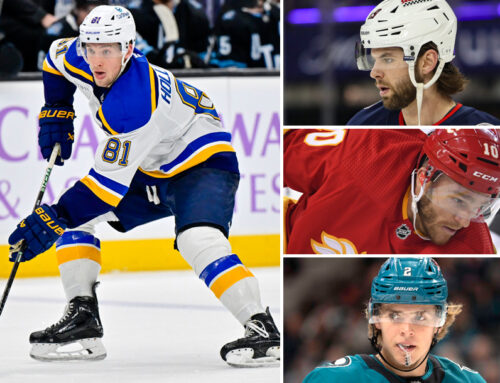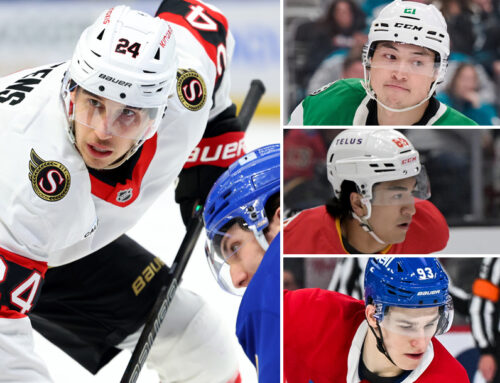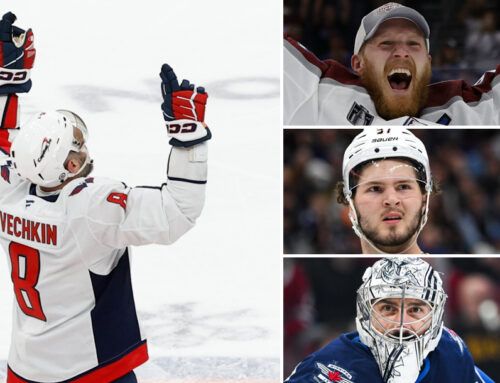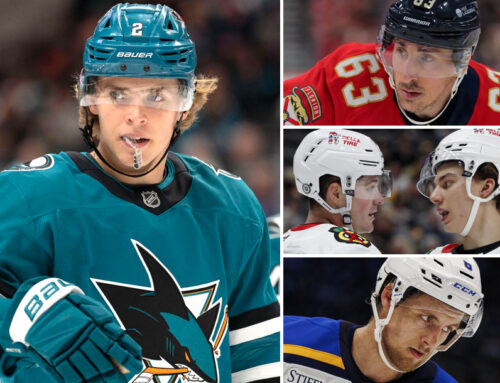Every Sunday, we share 21 Fantasy Rambles from our writers at DobberHockey. These thoughts are curated from the past week’s 'Daily Ramblings'.
Writers/Editors: Ian Gooding, Michael Clifford, Alexander MacLean, Brennan Des and Dobber
—
The 2024-25 Dobber Hockey Fantasy Guide is available in the Dobber Shop! The nice thing is that because it is digital-only, updates can be made as news changes, and there’s certainly been a lot of that this week.
Our French version of the Guide, Le Guide des Poolers, is also available via this link.
—
1. Since we are now in fantasy hockey draft season, I’m going to share a few of my thoughts about how to proceed with a draft. This is mainly intended for single-season leagues, but this could also be applied in those leagues that start with several keepers.
I’ve written about this topic in previous years and didn’t simply want to copy and paste what I’ve written in the past. So for something different, I’m going to present draft strategies in point/counterpoint form. After all, it’s important to have balanced opinions in today’s polarized world, isn’t it?
Have a plan, but be flexible.
It’s fair to decide you want to draft scorers early and load up on bangers later. Or that you are targeting a specific player in a certain round. Or that you know exactly who you’d take if both Jason Robertson and Tim Stutzle are available. Or that you’ve even gone to the trouble of generating your own rankings specifically for your draft. If you don’t have your own ranking system (or even if you do), I’d encourage you to read through as much of the Fantasy Guide as you can, or have at least read through the sections that matter most to you. Don’t be the Johnny-come-lately who buys the guide 15 minutes before the draft and then runs into technical issues when trying to access it for the first time!
At the same time, you may have heard Elliotte Friedman quote his grandmother: “You plan, God laughs” or Mike Tyson: “Everyone has a plan until they get punched in the mouth.” In other words, don’t get stuck to a specific plan. Adapt to how the draft plays out. Have a Plan B or multiple players queued up, because the time that someone will pick your player tends to most often be in the pick immediately before yours. Or it will be the same person doing it to you multiple times in a draft. I don’t know why that is, but it’s happened many times to me. Roll with the punches in your draft. (sept28)
[Follow the link for more…]2. It’s only the preseason and all of Auston Matthews, William Nylander, and John Tavares are already dealing with injuries. All of the injuries have been described using the words “day-to-day”, “minor”, “dinged up”, and “precautionary,” so none of these players need to be pushed down draft rankings. Just don’t be surprised if one or more of these players are held out of all of the Leafs’ remaining preseason games. It’s not as if they are playing for a spot in the lineup or anything like that. (sept28)
3. John Gibson won’t be ready to start the season after undergoing emergency appendectomy surgery this week. He is expected to miss the next 3-6 weeks, which should mean he will return between mid-October to early November. Gibson’s absence should move Lukas Dostal up the draft rankings a little bit, although I would try to steer clear of drafting any Anaheim goalie due to the team’s expected finish in the standings. I could actually see Dostal playing more games than Gibson this season. Oscar Dansk, who has had cups of coffee with the Golden Knights, looks like the next goalie up for the Ducks. (sept28)
4. The Kings have announced that Drew Doughty is month-to-month with a fractured ankle. Frank Seravalli also reported that surgery for Doughty will also likely include damaged tendon repair. Seravalli also estimates that Doughty will be out of the lineup for between 10-14 weeks, which would mean that Doughty could be ready to return sometime in December. Obviously not good news, but it could have been a lot worse. (sept28)
5. The Doughty injury has sparked the debate as to whether Brandt Clarke or Jordan Spence will move to Doughty’s spot on the top power play. I’d lean toward Clarke based on draft pedigree, but I wouldn’t rule out Spence here. Spence is two years older than Clarke and has more career NHL games under his belt (101 GP) than Clarke (25 GP). However, it’s not unprecedented for a player with little NHL experience to be on the top power play, with both Quinn and Luke Hughes being examples of this. Based on Friday’s practice, Clarke looks like the early favorite.
No matter what happens on the power play, both Clarke and Spence should benefit from an even-strength standpoint. Even at age 34, Doughty logs a ton of minutes (over 25 minutes per game in 2023-24), and someone has to make those up. In addition, Doughty, Clarke, and Spence are all right-shot defensemen. Tyson Barrie, John Klingberg, and Justin Schultz are also right-shot d-men, so it’s possible that the Kings sign one of these veterans to a one-year, low cap hit deal to help fill the void. (sept28)
6. Good news on the Artemi Panarin front, whose lower body injury doesn't seem serious. Hopefully he just needed a bit of rest and is good to go because the Rangers have had their fair share of injury scares already this preseason. (sept26)
Staying with NYR, defenceman Ryan Lindgren is week-to-week with an injury. Someone that wasn’t expected to make the roster now has a chance to break camp, and be in the lineup, for the start of the season. Also, Filip Chytil was at practice on Wednesday, so hopefully no worse for the wear after that injury scare on Tuesday night. (sept26)
7. Kaiden Guhle has resumed skating after having his appendix removed and it's good news for both the player and the Canadiens back end.: Tweeted @frankseravalli: He will be monitored on a daily basis.
8. Nick Bjugstad is not expected to be ready for the start of Utah’s regular season, per Craig Morgan. (sept26) Meanwhile, Nick Schmaltz is expected to be fully available from Monday on." (sept27)
9. It is interesting that Tomas Hertl keeps centering what would be the third line for Vegas, having Nicolas Roy and Alex Holtz as his flanks. I wonder how long that keeps up. (sept26)
10. Detroit had a preseason game against Chicago last Wednesday night and it’s notable that they ran Alex DeBrincat, Dylan Larkin, and Lucas Raymond together both at 5-on-5 and on the power play. It was a lineup with Patrick Kane and Vladimir Tarasenko, so nothing is guaranteed yet, but last season, that DeBrincat-Larkin-Raymond trio scored 4.5 goals per 60 minutes at 5-on-5. They did it while shooting 13%, which is too high, but even 11% would have them scoring goals at an elite rate. Lines rarely stay together all season, but it’s a big note from that squad. (sept26)
11. Some good news on the injury recovery front for Brad Marchand, who was in a full participation jersey this week (as reported by @conroyherald). Marchand had multiple offseason surgeries but looks to be good to go. He is coming off a 29-goal, 67-point season where he sustained those multiple injuries. There may be 70 points in the offing again. (sept26)
12. There have been nervous fantasy managers around the league as far as goaltending is concerned. Thatcher Demko‘s season out in Vancouver is still very muddled, Jeremy Swayman has yet to sign with Boston, and now another quick update on New York Islanders goaltender Ilya Sorokin:
Sorokin underwent back surgery in the offseason and that he’s not in camp right now is worrisome. Between Sorokin, Demko, and Swayman, there are question marks around what could be three of the top five fantasy goalies, at least if everyone was healthy. (sept26)
13. For today’s Ramblings, we’ll finish the week once again going over some of my forward point and shot projections for the 2024-25 season. Each of the last two Ramblings have covered them (here and here), and this will round out the trio.
A reminder on some of the caveats:
- Rookies are still not added – those come at the end, along with the age adjustments for all players.
- All players are projected for 82 games played.
- Assumptions are made in regard to player roles. For example, Anthony Duclair getting L1/PP1 time for the New York Islanders alongside Mathew Barzal and Bo Horvat is a much different outlook than an L2/PP2 role.
- I won’t release my full projections because Dobber has his own included with the 2024-25 Dobber Hockey Fantasy Guide that is available now in the Dobber Shop.
And with that, today I want to look at some of the younger, non-rookie players around the league. Data used for the projections comes from Natural Stat Trick and AllThreeZones. (sept27)
So far in the preseason, Quinn has been seen skating on Buffalo’s top power play unit. It is hard to overstate the difference between skating on the top power play unit and the second unit: over the last two seasons, the Buffalo Sabres have scored 10.6 power play goals per 60 minutes with Tage Thompson and Rasmus Dahlin on the ice, and 5.1 goals/60 with them off the ice. If things stayed equal and consistent, we are potentially looking at double the power play points, and that helps in several fantasy categories. In fact, for Quinn, that change in role brings his outlook from this: 82 GP, 23-33-56. To this: 82 GP, 25-40-65.
There are issues with this fantasy outlook, of course.
The first issue is whether he holds his power play role all season, or for even a vast majority. Few players maintain the same role all year, so whether it’s 90% of his time on PP1, or 60%, or 30%, makes a big difference. His 65-point outlook would depend on a PP1 role for at least 90% of the season, so if he’s off PP1 by November, well, that puts 60 points in doubt.
The second issue is Quinn’s shot volume. Over the last two seasons, he has managed just under 11 shots per 60 minutes with the man advantage. Among regular power play forwards in the league, that’s about the middle of the pack. On top of that, if he is on the top PP unit, it’s a unit with Thompson and Dahlin, and they can account for as much as 45% of the power play shot volume between the two of them. It leaves Quinn in a good spot to rack up power play assists, but not so much on the power play goal front.
Quinn is a player I’ve been very high on since his draft year and think he’s in line for a very long, very productive NHL career. As for 2024-25, he’s consistently going outside the top-175 picks, and that seems like fine value. A reminder that he racked up 12 blocks and 31 hits in his 27 games last season. If he can put up around 30 blocks and 75 hits, it does give him some peripheral coverage. He is a player worth considering around the 200th pick. (sept27)
14. Leo Carlsson
In yesterday’s Ramblings, we went over the outlooks for Trevor Zegras and Troy Terry, and neither was as high as I was expecting. It was discussed that once age adjustments were made to the younger players – Zegras included – that these may come up a bit. For now, this is what the projections are showing for Leo Carlsson: 82 GP, 20-32-52.
When age adjustments are made, this is probably closer to around 22-23 goals, 34-35 assists, and 180-185 shots.
As mentioned in Tuesday’s article, the big problem in Anaheim is the power play. In recent seasons, they haven’t drawn many opportunities per game and have often struggled to score on the ones they do get. Things should get a bit better this season, but they have a long way to go, and it’s hurting their fantasy upsides unless things really come together in 2024-25.
Also, Carlsson wasn’t much of a volume shooter last season on a per-minute basis, so even 18:30 per game and a 10% improvement in per-minute shot rate means 185 shots as the upside. A good season would turn 185 shots into 25 goals, so seeing him at 20 goals on 170 shots isn’t a shock. (sept27)
15. Adam Fantilli
Fantilli’s rookie season saw an 82-game pace of 20 goals and 25 assists, and that was skating 15:43 per game and shooting just 10.4%. However, his shot rate was in the 79th percentile of regular forwards (at least 750 total minutes played), and that’s the mark of a low-end first liner. He showed good passing data (very good for a rookie) and great controlled zone entry rates. The assumption is that he adds about a minute per game of even strength time and gets consistent top power play time. Add the excellent shot rates, improved role, and sterling puck control data, and we have this projection: 82 GP, 30-36-66.
The shot volume might seem high, but as a rookie, Fantilli landed just shy of 9.0 shots per 60 minutes and that’s Jack Eichel-As-A-Rookie territory. In Eichel’s second season, he put up over 4.0 shots per game. Now, that was with nearly 20 minutes per contest, and Fantilli’s outlook is in the 17:45 range, but that’s why he’s under 3.0 shots per game. If Fantilli can stay healthy, the only thing that will limit his shot volume is his role.
In strict hockey terms, Johnny Gaudreau‘s tragic passing influences the team’s outlook, but it is worth noting that Fantilli played less than 30% of his even strength time with Gaudreau in 2023-24. The young rookie is on a team that will struggle defensively but he profiles as a superstar in the making, and is consistently being drafted outside the top-150 picks this season. I would much rather draft him than Cutter Gauthier, let’s say. (sept27)
16. Marco Rossi
A lot of fantasy hockey fanatics, myself included, waited patiently for the season Rossi just had with 21 goals and 19 assists in 82 games. Among regular Minnesota forwards (at least 600 minutes), he trailed only Kirill Kaprizov and Matt Boldy in per-minute goal scoring at even strength. It was a good effort for a player who has had serious health issues in a few years ago.
In fantasy hockey, though, it is hard to see Rossi taking the next step in his potential upside because of his role. The Minnesota Wild have both Joel Eriksson Ek and Ryan Hartman, and, right now, they are the unquestioned top two centres on the team. Believe it or not, Rossi was used more at even strength than either of them, on a per-game basis, but none of them reached 15 minutes in even strength time per game. My projections have Rossi falling just short of 15 minutes per game in EV TOI which, alongside secondary power play time, means his expected ice time is a little over 17 minutes per game. It isn’t a lot, and Minnesota is a team that (correctly) uses its top power play unit heavily. Not having a top PP role greatly hurts his outlook, and gives us this projection: 82 GP, 21-27-48.
It is the same goal total with more assists. Once we adjust for his age, this probably comes up a bit to ~23 goals and ~30 assists. That might seem disappointing, but given a secondary PP role, it would mean about 21 EV goals and 21 EV assists. For reference, that is exactly how many EV goals and assists Steven Stamkos had in 2023-24. Rossi largely being kept away from Kirill Kaprizov at both even strength and the power play is likely the difference between a ~50-point season and a ~70-point season. Roles matter. A lot. (sept27)
17. I have zeroed in on a handful of my favorite selections after pick 150 or so. We’re using Yahoo’s ADP numbers because I really can’t understand Fantrax’s system that would have Connor McDavid down at seven, Charlie Lindgren at 11, and Steven Stamkos ahead of Auston Matthews. Here are a few notables:
Jonathan Huberdeau – I’m still not convinced that he’s completely cooked, but I am sure he’s never hitting the 115-point mark again. Somewhere in the middle lies where I think Huberdeau finishes this season. Dobber has him projected for 59 points in 80 games in the guide, but I think he tops at least 65, and depending on which direction his shot rate goes, I think there’s upside for a top-75 fantasy campaign out of him this year. That kind of player is available to you between picks 150 and 200, where most of these players are then going to be dropped for a hot hand by Thanksgiving anyways. (sept25)
18. Logan Stankoven – This is my rookie of the year pick. He has the talent, the support, and also the NHL experience with 14 points in 24 regular season games, and eight points in 19 playoff games. With Joe Pavelski gone, Stankoven can slide up into the top-six, right away, and with the intensity and skill that he brings he’s not going to be demoted after that. He doesn’t have the same point-per-game upside as a few of these other players do for this upcoming year, but I like the floor/ceiling combo just as much.
Kirby Dach – He’s been mentioned a lot this offseason, but I’ll say it again. After missing almost all of last season with an injury and being reinforced on the second line with Alex Newhook and Patrik Laine, Dach becomes an intriguing option if you know what you’re signing up for. Unfortunately, his peripherals are a little soft, with under two shots per game, under one hit per game, a possible lack of PP1 exposure this year, and a faceoff win percentage under 40%. It’s his point scoring that brings his value though, and he should be viewed as a 60+ point scorer this season if he remains healthy. (sept25)
19. Pavel Mintyukov & Owen Zellweger – Cam Fowler has been an exceptional and underrated power play threat over the last number of years, but it appears his time on the top unit may be over soon. Either or both of Owen Zellweger or Mintyukov would make an excellent top power play quarterback, and both will likely need to be a bit more sheltered than Fowler at even strength. Zellweger got some tougher assignments and did well last year, while Minty was more sheltered but did see some PK ice time. Both put up similarly good power play numbers, and it could be either one taking the reins (or possibly both, either on one unit or split between two equivalent units). Of the two, I’m more ready to gamble on Mintyukov who has a few more games of experience and provides better peripherals for fantasy as well.
K’Andre Miller – Defencemen are in short supply after pick 150, let alone into the 200s, but that’s where someone like Miller can provide some amazing rewards. Miller has been a favourite of mine for years now, and with Gustafsson gone he should be able to take over the PP2 job now in addition to being an excellent two-way defenceman at even strength. He provides excellent Hit + Blk numbers, so if he could bring his shot totals up above the 1.5 per game mark, then he would be a fantastic peripheral contributor. If the scoring can get back to the 45-point-pace of two seasons ago rather than last year’s 30-point pace, then even better. (sept25)
20. With Sidney Crosby now signed we can turn our curiosity towards what his fantasy production will look like next year. We know he’s one of the best players of all time, but he is also 37, and he won’t be amazingly productive forever. Four of his previous five seasons saw him post between a 90- to 95-point pace, which is both excellent and extremely consistent. Those five years are also five of his best seven campaigns from the last decade.
Crosby’s underlying numbers also show no sign of slipping, and with no signs anywhere of an age-related decline, it’s fair to assume that another 90-point season is in the cards. What is even more interesting, is that Crosby’s peripherals have risen over the last few years, with his shot rate rising each of the last five years – up to 3.4 per game last season – and his hit rate jumping to 1.23 per game, which is a career high. The hits we can’t bet on continuing, though they might as Crosby’s game seems to be evolving and adjusting as he ages, and this could be one layer of it. If he can keep up both the peripherals and the scoring, he’s easily worth a top-15 pick this year in any league format. (sept25)
21. When sharing five tips for your fantasy draft, I made the obvious claim that not every player elevates their game when they’re in the final year of a contract. One of our lovely readers, Glenn, aptly pointed out that having real data behind that claim would make it more useful. If pending UFAs elevate their game only 10% of the time, then maybe it’s not worth considering contract status in preparation for your fantasy draft. However, if that percentage is significantly higher, maybe the contract effect is worth factoring into your draft strategy. In this week’s Ramblings, we’ll crunch the numbers to help inform your decisions.
The Sample
For a given year, I used PuckPedia to find players that were set to become unrestricted free agents at the end of that season.
To get a sense of which names were fantasy relevant at that point in time, I chose players who tallied at least 0.45 points per game in the previous season. Players that signed extensions before starting the final year of their contract were excluded from my analyses, as were players who played less than 20 games in their contract year.
You’ll notice that since my method requires players to score at roughly half a point per game prior to their contract year, I miss players who come out of nowhere to thrive in the final year of their deal, like Valeri Nichushkin and Mason Marchment in 2021-22. These cases were rare and wouldn’t throw off the trends very much, but it’s important to note they exist. In addition, I think there are more reliable markers that help us identify these ‘breakout’ players than just contract status. For instance, when Nichushkin posted a 31-point pace in 2020-21, he was skating 14 minutes a night. When he broke out with a 69-point pace in 2021-22, his average ice time was up at 19 minutes and his linemates were significantly better. As a result, it seems unfair to say his success was largely driven by contract motivations. (sept23)
[Follow the link for the full analysis…]—
Be sure to also grab your copy of the 2024 Dobber Fantasy Hockey Prospects Report!
—
Have a good week, folks!
Thanks for continuing to support the website and if you’re bored and need a fantasy hockey fix – visit the gang in the forum here.





 WSH
WSH MTL
MTL T.B
T.B FLA
FLA WPG
WPG STL
STL N.J
N.J TOR
TOR PHI
PHI CAR
CAR EDM
EDM MIN
MIN DAL
DAL
